Sometimes it's not just the little things, but the invisible things that matter. This is even true in the world of technology, where the focus on the physical characteristics of devices such as smartphones, or the visual aspects of the applications and services that run on them, is so dominant.
At MWC last week, the importance of this observation became apparent on many different levels. From technologies being introduced to create the invisible wireless networks that our smartphones are so dependent on, to the semiconductor chip innovations hidden inside our smartphones, to the testing required to make all of this work, these "invisible" developments were some of the biggest news to come out of the show.
On the network side, discussions focused entirely on the equipment necessary to create next-generation 5G networks and real-world timelines for delivering them. Historically, MWC was a telecom equipment show, and its heritage shown through strongly this year. Traditional network infrastructure companies such as Ericsson, Nokia, and Huawei were joined by relative newcomers to this particular area, including Intel and Samsung, to talk about how they're planning to deliver 5G-capable equipment to telco operators such as AT&T, T-Mobile, and Verizon later this year.
The details behind 5G network equipment technologies, such as millimeter wave, network slicing, and others, become extraordinarily complex very quickly. The bottom line, however, is that they're going to enable 5G networks to support not only significantly faster upload and download speeds for 5G-enabled smartphones, but also much more consistent speeds. This translates into smoother experiences for applications such as high-resolution video streaming, as well as new kinds of applications that haven't been possible before, such as self-driving cars.
To make this work, new types of 5G-capable modems are needed inside next generation smartphones, automobiles and other devices, and that's where chip companies like Qualcomm and Intel come in.

One of the great things about the forthcoming transition to 5G is that existing 4G LTE modems and the devices they currently are used in (specifically, all our current smartphones) will be able to connect to and work with these new 5G networks.
New telecom industry standards were specifically designed to initially put new 5G enhancements on top of existing 4G ones, thereby guaranteeing compatibility with existing devices. In fact, there are even some situations where our current smartphones will get a bit faster on 5G networks as 5G phones becomes available, because the new phones will essentially move their traffic onto new lanes (radio bands) of traffic, reducing congestion for existing 4G devices. Eventually, we will move beyond what is termed these "non-standalone" or NSA, generation networks to standalone (SA) 5G-only networks, but for the next several years, the two network "generations" will work together.
Another "hidden" technology enabling modern smartphones is the testing that's necessary to make all these devices and networks work together.
At last year's MWC, Qualcomm introduced a prototype of the world's first 5G-capable modem (the X50). With the recent finalization of the 5G radio standard (called 5G NR) last December, this year they discussed the first successful 5G tests using the X50 to connect to network equipment from providers like Ericsson and Nokia. More importantly, they announced that the X50 would be shipping later this year and that the first 5G-capable smartphones will be available to purchase in early 2019.
Intel and Huawei also joined the 5G modem fray this year. Intel discussed their own successful trials with their prototype 5G modems and said that they would provide both a 5G modem for PCs and, thanks to work with chip company Spreadtrum, a 5G modem and applications processor for smartphones by the end of 2019. Huawei's new modem is much larger and won't be in smartphones initially, but instead will be used for applications such as 5G-based fixed wireless broadband services for home or business internet connections.
Another "hidden" technology is the testing that's necessary to make all these devices and networks work together. Companies like National Instruments (NI) have worked silently in the background for the last several years creating test equipment and test beds that allow chipmakers, device makers, network equipment makers and telecom carriers to assure that the new standards at the heart of 5G actually work in their simulations of real-world environments. At MWC last week, NI showed a new 5G NR radio emulator, a new millimeter wave test bed in conjunction with Samsung network equipment, and an analog RF front end for 5G modems done in conjunction with Qorvo.
As we bury ourselves in our daily smartphone usage, it's easy to forget how much technology is working behind the scenes to ensure that they deliver all the capabilities to which we've become accustomed. While there's little need for most people to think about how it all works, it's still important to know that the kinds of "invisible" advancements that were presented at this year's MWC offer a strong path for smartphones' continued and growing use.
Bob O'Donnell is the founder and chief analyst of TECHnalysis Research, LLC a technology consulting and market research firm. You can follow him on Twitter @bobodtech. This article was originally published on Tech.pinions.